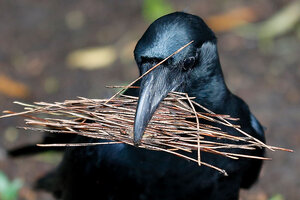We are observed
We saw their comings and goings. Then we found where they went.

A crow gathers nesting material.
Shizuo Kambayashi/AP/File
“There they go, catching the 6:15 again!”
The neighbors. We didn’t know where they went every night, but they always left around the same time. It gets embarrassing when you’ve lived near folks for a long time but still don’t know much about them. After a while, it’s too late to introduce yourself. And, to be clear, these are the kind of neighbors that are always hanging out with their friends and making a racket.
That’s pretty much all that crows do. Or so we thought, because we didn’t pay much attention. We did notice they all started flying at dusk, and always in the same direction. Were they going to their book club? We didn’t know. For years.
But then we started paying attention.
The racket starts up in spring. Everyone’s flying around with sticks for a nest. There will always be at least one bird bleating regular as a metronome except for intermittent strangled sounds when something is being jammed down its throat. We figured it must be the baby, but it turns out Mama does it also.
I, too, have been known to squawk for food. I began to feel more tolerant.
The whole family gets in on the business of new-crow manufacture. There is food to haul in, there are hawks to harass. When the blue-eyed progeny stumble to the ground for a few flightless days, a crack team of attack crows attends them. Even the neighborhood cats are cowed.
And nobody goes anywhere for months – not during crow-training season. Evidently this takes a lot out of a bird, because ’long about August, they start looking distinctly disheveled. They really let themselves go. Their vests are tatty, their wings are gapped. Tail feathers litter the lawn. It’s embarrassing. But then the new suits come in, everyone’s all shined up, and they’re ready to roll.
And where they roll – kids, kin, and caboodle – is downtown. It’s party time.
Evidently, all this time, for all these years, all the crows for miles around have headed to the center of the city to occupy any suitable patch of tree-lined blocks. Thousands of them. They stream in at dusk on citywide radii, and they roost. It’s a little warmer, there’s safety in numbers, and let’s face it – they like each other. Plus, there’s so much to talk about. The adults gossip. The adolescents check each other out. The kids make crank caws. Then they all settle down for the night. Come dawn they fly back to their ’hood and do it all over.
So. We thought we had it all figured out. And then there came the winter night my friend and I were downtown, attending a lecture. I didn’t even recognize the polka dots gleaming in profusion on the pavement at first: They looked like an art project. Usually when you see, um, bird evidence, it’s clumped up under a street lamp or some other perch. These were evenly spaced spangles and absolutely everywhere. I joked we shouldn’t look up. Learned that lesson before.
But we couldn’t help it. We looked up. And there, in every elm, for blocks and blocks, large black shapes were cut out against the starry sky, sleeping crows in the thousands, presiding over us heedless goofs below with our blathering and our headlights and our traffic and our pointless noise. A soft stratum of feathered life, a blanket over us all.
We are observed, and we are oblivious. We knew about the roosts. But we’d never looked up.


